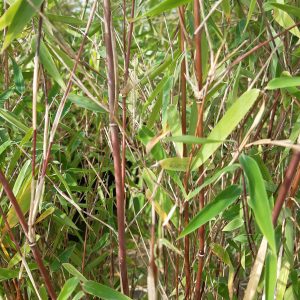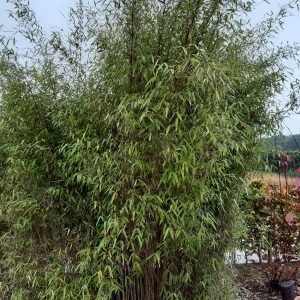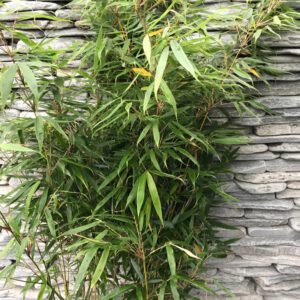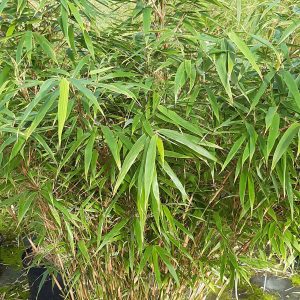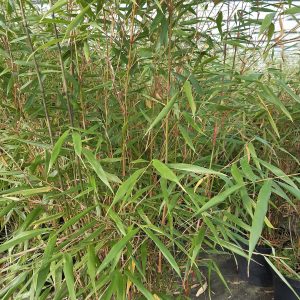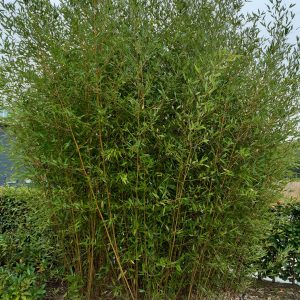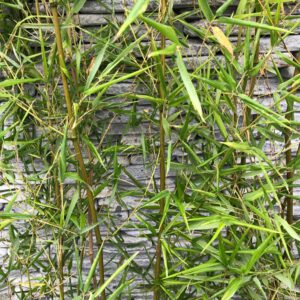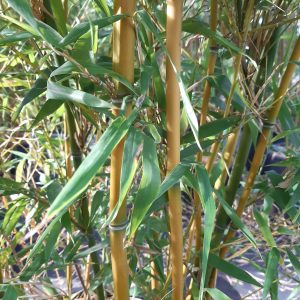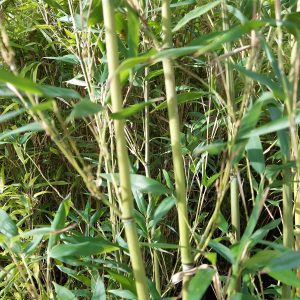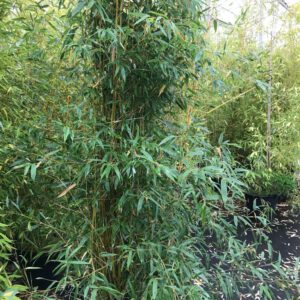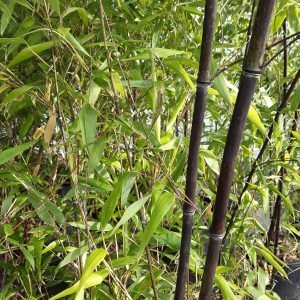The Bambuseae are the most diverse tribe of bamboos in the grass family (Poaceae). The origin of the word Bamboo comes from the Malay word “Mambu”. Malay is the national language of Malaysia and Indonesia. In the late 16th century (1590-1600) the Dutch named it “Bamboes” after which it got its Neo-Latin name “Bambusa”. Bamboo comprises of many different species which all have unique growth rates and characteristics.
Showing 1–12 of 17 results
Fargesia ‘Juizhaigou’
Fargesia ‘Juizhaigou’
Clump-forming bamboo. Excellent when planted in semi-shade, where the mixture of green, purple and reddish canes are topped with dainty small dark green leaves. ‘Juizhaigou’ makes a superb specimen plant with it’s upright fountainous habit and can. Non-invasive. Hardy.
Eventual size: 2.5 to 3 m
Position:
![]()
![]()
![]()
Fargesia nitida ‘Great Wall’
Fargesia nitida ‘Great Wall’
This new clone is an exciting, erect and robust growing cultivar that is close to the original form. Canes are initially upright, successive years growth make them arch elegantly under the weight of foliage – itself mid-green and generously produced on many side branches. Makes a perfect single lawn specimen or multi-planted as a screen or hedge. Best in shade in moist soil.
Non-invasive. Evergreen. Hardy.
Eventual size: 2,5 to 3 m
Position:
![]()
![]()
Fargesia robusta ‘Pingwu’
Fargesia robusta ‘Pingwu’
This is one of the most upright and compact Fargesias, with lovely dull green straight canes. The emerging culms are a startling green and show up well against the white culm sheaths in the spring. This bamboo will reach up to 3-5 m in height and is a well behaved clump former which will not mind growing in a shady spot. Non-invasive. Hardy, evergreen.
Eventual size: 3 to 5 m
Position:
![]()
![]()
![]()
Fargesia Rufa
Fargesia Rufa
Small to medium sized, well behaved bamboo. Develops into a compact arching specimen. It has masses of small leaves on top of orange /green stems. Very hardy and tolerant of shade. Plant in good, rich soil and keep well watered until established to achieve the best possible results. Looks especially good in a container. Hardy and easy to grow. Non-invasive. Evergreen.
Eventual size: 2,5 to 3 m
Position:
![]()
![]()
![]()
Phyllostachys Aurea
Phyllostachys Aurea
The Golden Bamboo or Fishing Pole Bamboo, has dark green canes maturing to a golden yellow. Nice and bushy and excellent as a screen. Will reach a height of between 4 and 5 metres. Easy to distinguish from other bamboos by the crowded nodes at the base of the canes. Invasive, hardy. Eventual size: 4 to 5 m
Position:
![]()
![]()
Phyllostachys Aureosulcata
Phyllostachys Aureosulcata
A hardy bamboo that has a yellow strip on a dark green culm. This is one of the hardiest bamboos. Although one out of about 10 culms have abrupt zig-zags in the lower portion, it is rigidly upright, which makes it good to plant near a walk or driveway to create an evergreen screen for privacy.
Eventual size: 6 to 8 m
Position:
![]()
![]()
Phyllostachys Aureosulcata ‘Aureocoulis’
Phyllostachys Aureosulcata ‘Aureocoulis’
The Golden crookstem bamboo (so called due to its occasional kinked new growth) is a wonderfully dainty bamboo with bright gold canes and airy foliage. The emerging canes are blushed pink in strong sunlight, making this a very attractive specimen . Invasive. Hardy.
Eventual size: 6 to 7 m
Position:
![]()
![]()
Phyllostachys Humilis
Phyllostachys Humilis
Very hardy and attractive bamboo with culms that emerge reddish brown, turn dark green then aging to orange-yellow in sun. It is one of the shortest members of the genus but also quite active at the roots, which means it can quickly establish a dense medium height evergreen screen or hedge. Invasive.
Eventual size: 4 to 5 m
Position:
![]()
![]()
Phyllostachys Nigra
Phyllostachys Nigra
Phyllostachys nigra or the Black Bamboo has to be the most popular and best known of all bamboos. The jet black canes reach around 4 or 6 metres in height and are covered in masses of lush green dainty leaves. The best situation for the black bamboo is in a good, rich soil that does not dry out too readily but also does not have a tendency to waterlog over the winter months.
Eventual size: 4 to 6 m
Position:
![]()
![]()
Phyllostachys Vivax ‘Aureocoulis’
Phyllostachys Vivax ‘Aureocoulis’
This majestic bamboo, with its towering spires of golden yellow culms painted with random green stripes, is truly a sight to behold. Like other large bamboos, Phyllostachys vivax ‘Aureocaulis’ will appreciate the sunniest location possible. Invasive.
Eventual size: 8 to 10 m
Position:
![]()
![]()

 Nederlands
Nederlands Français
Français
